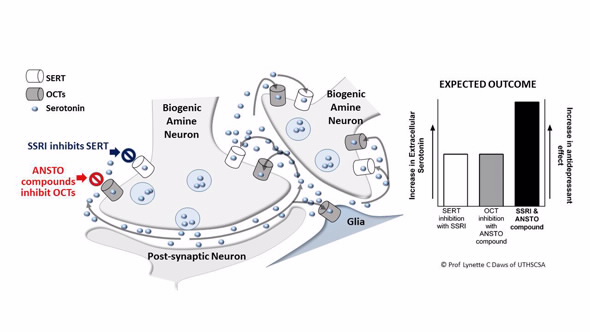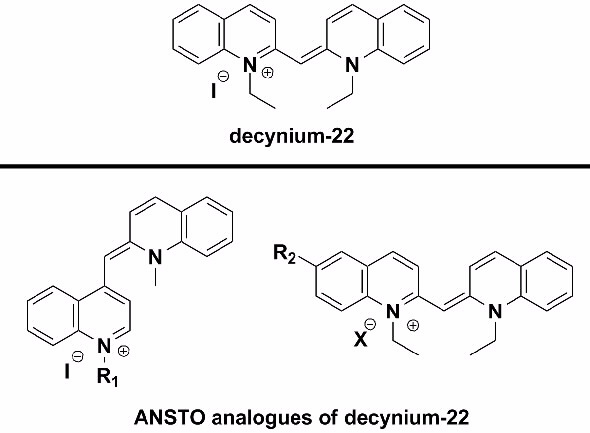
ANSTO Human Health researchers have co-led an international team investigating new treatments for depression. This research, recently published in the European Journal of Medicinal Chemistry, by a large team co led by Dr Benjamin Fraser and Dr Paul Callaghan at ANSTO, and Prof Lynette Daws of The University of Texas Health Science Center at San Antonio (UTHSCSA), evaluated antidepressant-like properties of novel compounds in preclinical behavioural and pharmacological studies.
This study sets the stage for further exploration of new compounds that will help researchers to develop new treatments for depression; treatments with therapeutic outcomes that improve upon selective serotonin reuptake inhibitors (SSRIs), the most commonly prescribed antidepressants, which are ineffective in many patients.
The new compounds are analogues of decynium-22 (D-22), a compound that blocks transport of “mood controlling” chemicals, called neurotransmitters, into neurons. D-22 does so by blocking transporters distinct from those blocked by SSRIs.
Importantly, preclinical research by Prof. Daws’ group showed that D-22 has potential as an “adjunct” treatment for depression. “Adjunct” means that when D-22 is co administered with an SSRI, the combination enhances extracellular serotonin levels through greater inhibition of serotonin clearance, and produces greater antidepressant-like effects, than that achieved with the SSRI alone.
The problem with D-22 is that it blocks transport of “mood controlling” chemicals via at least four different transporters.
“To understand the mechanisms by which D-22 augments the antidepressant effects of SSRIs we need compounds that are specific for each of these transporters” said Fraser.
The new analogues of D-22 were developed in the Radioisotopes and Radiotracer laboratories at ANSTO and then sent to Prof Daws at UTHSCSA, where they were evaluated for their antidepressant-like activity and binding profile to receptors than can mediate unwanted side effects. 
“We found that some ANSTO compounds had interesting pharmacological profiles including less potent binding at receptors that mediate adverse side effects. Importantly, we also found that the same ANSTO compounds have potential as stand-alone therapeutics, without the need for also administering an SSRI” said Fraser.
At this stage, the exact mode of action of the ANSTO compounds has not been fully characterized but the most likely explanation is inhibition of transport of neurotransmitters like serotonin. The international team is aiming to publish their next extensive study on how the compounds work very soon.
Numerous underlying biochemical mechanisms are thought to contribute to depression and much research has focused on serotonin transporter (SERT). Prof. Daws’ research suggests that substantial uptake of serotonin by non-SERT transporters contributes to poor therapeutic outcomes following treatment with classic antidepressant medications.
“Not only have we potentially discovered an exciting, new treatment for depression, but the compounds are helping Prof. Daws unravel the underlying mechanisms that contribute to poor antidepressant efficacy and treatment of other related mood disorders through the use of nuclear science and technology,” said Fraser.
SSRIs, such as citalopram and fluoxetine, block SERT but do not work for everyone with depression, suggesting there is another mechanism depleting extracellular serotonin.
It is strongly suspected the ANSTO compounds inhibit this other mechanism, contributing to their antidepressant-like effects.
“Prescribing medication for patients suffering depression is a significant challenge, and picking the right treatment is often a guessing game. Our new compounds may not only help treat depression, but in the future we could develop a first-in-class tool to study these transporters in humans. This could help doctors tailor treatment for individuals, which would be an enormous benefit to patients as it can take months to conclude that an antidepressant is not working adequately,” said Fraser.
A large number of ANSTO, national and international researchers contributed to this project including Naomi Wyatt, Dr Anwen Krause-Heuer and Dr Maxine Roberts who synthesised and isolated the active compounds.
The large team also involved post-graduate students supervised by Prof Naresh Kumar from The University of New South Wales and Dr Nial Wheate from The University of Sydney.
The team from UTHSCSA, which is led by Prof. Daws, included Dr Rheaclare Fraser-Spears, a postdoctoral researcher, who undertook much of the pharmacological experiments, and Dr Wouter Koek who led the animal behaviour studies.
http://www.sciencedirect.com/science/article/pii/S0223523417304579
Published: 05/07/2017

